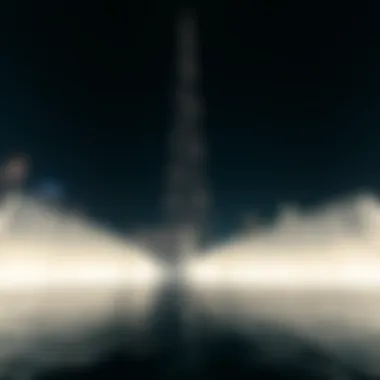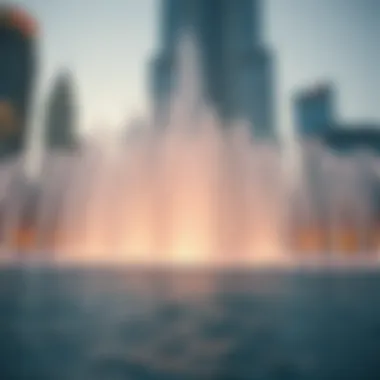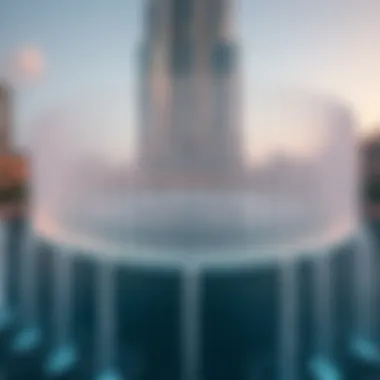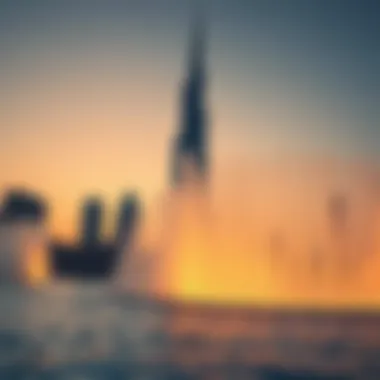The Dancing Waters of Burj Khalifa: An In-Depth Look


Intro
The Burj Khalifa, standing tall at 828 meters, is not just a testament to modern engineering; it hosts the enchanting fountain system that mesmerizes five million visitors each year. The fountain’s lively display, set against the backdrop of the world's tallest building, creates a captivating spectacle that draws eyes both day and night. With water dancing gracefully to the rhythm of music, it has become an integral part of Dubai's identity.
As this article unfolds, we'll take an in-depth look into the workings of this inspiring installation. From its architectural significance to the technology behind the scenes, there’s much to explore. We’ll also glean into how this stunning water feature influences Dubai’s tourism and real estate, offering insights that intertwine culture, innovation, and investment opportunities.
The conversation about the fountain system extends beyond mere aesthetics; it probes the heart of what Dubai is today and hints at where it’s headed in the future. For investors and stakeholders, understanding the dynamism of this attraction provides a dual advantage: appreciation of its touristic value and realization of potential investment in the vibrant real estate market surrounding it.
Expect a rich narrative that deepens your understanding of the fountain and its broader implications within the urban landscape of Dubai.
Understanding the Burj Khalifa Fountains
The Burj Khalifa fountains are not merely a visual spectacle; they are an essential part of Dubai’s cultural and architectural identity. Understanding these fountains allows one to appreciate their artistry, engineering, and the emotions they evoke. Much like a finely choreographed dance, these dancing waters tell a story that resonates with both locals and tourists alike. They reflect Dubai’s ambition and creativity, while also showcasing the advanced technology that can transform water into a dynamic form of entertainment.
Knowing the fountains’ intricate mechanisms, historical backdrop, and design philosophy provides a fuller picture of their significance within the grand scheme of the Burj Khalifa. Furthermore, they enhance the experience for visitors, increasing the footfall in the surrounding areas and boosting local tourism. In essence, the fountains have elevated the Burj Khalifa from just an architectural marvel into a cultural icon.
Historical Context
The inception of the Burj Khalifa fountains coincides with the building's ambitious construction start in 2004. Designed to complement the tallest structure in the world, the fountains draw on a rich tradition of water features in Middle Eastern architecture. Historically, water has always symbolized life and prosperity in the arid landscape of the UAE. The Burj Khalifa fountains connect this heritage with modernity, showcasing a blend of historical influences and contemporary artistry.
Originally, the idea for the fountains was born out of a desire to create a dynamic attraction that contrasted with the static nature of traditional fountains. Developed by WET, an American company renowned for their water features, the Burj Khalifa fountains are inspired by a variety of styles from around the world. They echo the designs found in famous fountains like the Bellagio in Las Vegas but take it a step further by incorporating Middle Eastern cultural elements. This rich intermingling of influences not only enhances the uniqueness of the experience but places it firmly within the context of Dubai’s rapid evolution.
Design and Aesthetics
In terms of design, the Burj Khalifa fountains are a visual feast. Set against the towering backdrop of the skyscraper, they are thoughtfully orchestrated to correspond with a variety of music genres, including classical and contemporary Arabic melodies. The visual effect of the water, shooting up to 500 feet in the air while illuminated by intricate lighting, creates a spectacle that captures the imagination.
Each performance is choreographed to ensure that the water dances in harmony with the music, creating a performance that can mesmerize viewers. The LED lighting system, which employs over 6,000 lights, adds depth and complexity to the experience, enabling the fountains to change colors and create patterns that feel both organic and surreal. This bridge between nature and high technology encapsulates the essence of modern Dubai, attracting not just sightseers, but also those wishing to delve deeper into the artistic vision behind the spectacle.
Engineering Breakthroughs
From an engineering perspective, the Burj Khalifa fountains represent an astounding feat of design and innovation. These fountains are powered by a system of high-capacity pumps that can push water through various nozzles, creating differing heights and effects depending on the desired performance. The technology used is a stark contrast to more traditional designs, showcasing advancements in fluid dynamics and mechanical engineering.
The fountains are situated over a 30-acre manmade lake, which serves as both a visual asset and a reservoir. This lake is part of an efficient water management system designed to recycle water throughout the fountain's operation. Such innovations ensure sustainability while delivering a breathtaking show. Moreover, this engineering brilliance does not stop at functionality; it extends to safety protocols implemented to maintain the show without compromising the experience. Each show seamlessly combines artistry and technical prowess, offering a glimpse into the future of architectural water features.
The Mechanics of the Fountain System
Understanding the mechanics behind the Burj Khalifa fountain system is crucial for grasping how this architectural feat operates seamlessly within the vibrant landscape of Dubai. Each facet of the fountain’s mechanics is a study in precision and innovation, reflecting not only engineering prowess but also an understanding of the cultural and aesthetic significance it holds in this desert metropolis.
Water Source and Management
The fountain system pulls its water from an underground network designed specifically for large-scale use. This sustainable source taps into aquifers that lie beneath Dubai, ensuring that the fountains have an adequate supply without depleting the city’s precious resources. With the staggering volumes of water involved—up to 22,000 gallons in action at once—effective management becomes a pivotal concern.


To maintain its environmental integrity, the Burj Khalifa adopts a closed-loop system that recycles water. This recycling not only minimizes waste but also reduces the need for fresh water, proving essential in a region where this resource is scarce.
"The harmony between grand design and ecological responsibility is one of the hallmarks of modern engineering found in Dubai."
In practical terms, the management involves regular monitoring of water quality and flow rates, ensuring that each performance is as spectacular as the last. Proper maintenance procedures are undertaken routinely, addressing any potential issues promptly before they escalate.
Pumping Technology
The beating heart of the Burj Khalifa fountains is undoubtedly its pumping technology. Utilizing high-capacity pumps, the system can propel water to heights exceeding 500 feet, creating dramatic jets that dance in the air. These pumps are sized for efficiency and reliability, featuring state-of-the-art materials to withstand continual exposure to water and the mini-environments they create.
Moreover, each pump is programmed to work in coordination with the fountain’s choreography. This synchronization is not only a feat of mechanical engineering but also a marvel of digital technology, combining to produce performances that seem to transcend the physical limitations of water.
Key components of this technology include:
- Variable Frequency Drives (VFDs): These control pump speeds, allowing for dynamic water movement.
- Multi-tiered Pump Systems: Providing redundancy and enhancing performance consistency during shows.
The integration of such advanced technology ensures that the fountain can maintain its captivating displays, even when crowd levels fluctuate significantly.
Lighting and Special Effects
No discussion of the Burj Khalifa fountains would be complete without considering the artistic elements: lighting and special effects. Encompassing an array of colored lights that can be synchronized with the water displays, the lighting transforms the fountains into a majestic light show that perfectly complements the night sky.
The use of energy-efficient LED technology not only elevates the visual spectacle but also aligns with Dubai’s commitment to sustainability. Special effects involving fog and fire elements further enhance the aquatic display, weaving intricate narratives that resonate with both local lore and global audiences.
Each performance is meticulously crafted, telling a story that engages onlookers while showcasing technological advancements in theatrical lighting. The fountain’s choreography changes seasonally or for special occasions, ensuring that each visit offers something new and exciting.
In summary, the mechanics of the fountain system at Burj Khalifa represent a blend of complex engineering, sustainable practices, and cultural artistry. The coordination of water management, pumping technology, and special effects creates an iconic spectacle that defines the Dubai skyline and enriches its cultural landscape.
The Cultural Significance of the Fountains
The Burj Khalifa fountain system isn’t just a spectacle; it represents a burgeoning identity for Dubai, encapsulating a blend of modernity, culture, and tradition. This aspect is crucial, especially considering how the heart of Dubai beats through its architectural marvels, with the fountain standing as a symbol of the city’s aspirations and values. The fountain system does not merely enhance the skyline but also enriches the experience of those who visit and live in the surrounding areas. Understanding its cultural significance sheds light on its important role within this vibrant metropolis.
Symbolism in Modern Architecture
The Burj Khalifa fountains are more than a display of water and music; they symbolize the innovation and forward-thinking spirit that define modern architecture in Dubai. As a central piece in the heart of the city, these fountains connect the past to the present, attracting a global audience while honoring Middle Eastern artistry and craftsmanship. They are designed to resemble traditional water features found in historical Islamic architecture, yet they are executed with cutting-edge technology, making them uniquely emblematic of what Dubai has achieved in modern times.
The fountains harmonize aesthetics with function, creating an ambiance that attracts both tourists and locals alike. The visual impact is amplified with each light and sound display, as they reflect the architectural lines and grandeur of the Burj Khalifa itself. A fine example is the synchronization of water jets into an intricate dance, echoing the aspirations of a city that has transcended its desert roots to become a beacon of modernity.
"The fountains are not just art, but a spirit—a reflection of the hopes and ambitions of the people who call Dubai home."
Integration with Local Culture
These fountains also weave into the fabric of local culture, offering an experience that resonates with both the tourist and the local populace. They provide a space for gathering and celebration, fostering community connections. Residents often flock to the area during special occasions or holidays, where the fountains truly come alive through thematic performances. For instance, during Eid celebrations or national holidays, special shows can ignite the skies, drawing in crowds and creating a sense of unity and pride among the spectators.


Moreover, the design of the fountain system pays homage to Arabic artistic traditions, incorporating elements that are recognizable and cherished by the local population. This blend of modern performance art with themes from the past fosters an environment that respects heritage while embracing change, making the fountains a pivotal point of cultural integration in Dubai.
Public Perception and Experience
The public perception of the Burj Khalifa fountains is overwhelmingly positive; they are seen as a must-see feature in Dubai that complements the lavish lifestyle associated with the city. Visitors often express admiration for the dramatic displays that combine artistry with technology, enriching their overall experience in the heart of the city.
That's not all; even residents find joy in watching the shows. The fountains create a sense of belonging and nostalgia, each show reflecting the various moods and moments that audiences can connect to in their lives. Parents bring their children to watch in awe, friends gather to celebrate weekends, and couples find romantic moments as they revel in the beauty of the dancing waters.
Local businesses also benefit from the crowds attracted to the fountains, which adds to the economic ecosystem in the area, reinforcing the connection between this tourism draw and its pivotal role in community life.
Impact on Tourism and Real Estate
The fountain system at Burj Khalifa serves as a key player in shaping Dubai's tourist landscape while simultaneously influencing the local real estate market. This dual impact appeals to investors, property developers, and expatriates seeking profitable opportunities in a city renowned for its ambitious projects. The fountains are much more than mere spectacles of water and light; they are pivotal components of a larger economic ecosystem that contributes significantly to tourism and real estate developments.
Tourist Attractions in Proximity
Surrounding the Burj Khalifa, several attractions make this area a magnetic focal point for visitors. The Dubai Mall, one of the world's largest shopping and entertainment destinations, is just a stone's throw away. It offers not only retail therapy but also an array of dining options and attractions like the Dubai Aquarium and Underwater Zoo. The proximity of such attractions creates a synergistic effect where tourists flock to the fountains, then spill over into adjacent venues.
Additionally, the Dubai Opera, located near the fountain, adds an artistic flavor that enhances the area’s appeal. Visitors often coordinate their schedules to catch a performance and then enjoy the spectacular fountain show. This seamless integration of culture and leisure contributes to a vibrant atmosphere that keeps tourists coming back. The interplay between the fountain and nearby attractions enhances the area's reputation as a must-visit destination, thus driving foot traffic and boosting local businesses.
Real Estate Developments Nearby
The fountains have catalyzed a flurry of real estate developments in the surrounding area. High-end residential projects, luxury hotels, and commercial complexes continue to rise, with many developers leveraging the fountain's status to attract buyers and tenants. Properties with a view of the fountains command a premium; it’s not uncommon for apartments to tout their direct sightlines of the nightly displays. This trend illustrates the fountains' role as a magnet for both investment and residency.
Moreover, developments like the Address Downtown and the forthcoming Burj Vista have capitalized on the proximity to this iconic landmark. Real estate agents often emphasize the lifestyle benefits of living close to the fountain, where residents can enjoy front-row seats to one of the world’s most famous water displays. Consequently, the surrounding real estate continues to thrive, driven by both domestic and international demand.
Economic Contributions
The Burj Khalifa fountain system contributes significantly to Dubai's economy in various ways. Firstly, it serves as a crucial element in the tourism sector, attracting millions of visitors annually, thus creating job opportunities in hospitality, entertainment, and retail sectors.
A closer look reveals that the influx of tourists leads to increased spending, from hotel bookings to dining and shopping, making the fountains a vital cog in the wheel of Dubai’s economic engine.
"The dancing waters are not just a visual feast; they are an indispensable economic driver for the city."
Additionally, the real estate boom around the Burj Khalifa elevates property values, promoting financial growth across the board. The demand for luxury living spaces contributes to a robust construction industry, which in turn boosts employment rates.
In summary, the Burj Khalifa fountains serve as a linchpin for both tourism and real estate, reinforcing Dubai’s status as a premier global destination. Their importance cannot be overstated, as they encapsulate a brand of urban luxury that resonates with affluent visitors and investors alike.
Environmental Considerations
The Burj Khalifa fountain system is not just an awe-inspiring sight, but also a project that brings to light the importance of environmental considerations in modern architecture. As sustainability becomes an increasingly urgent discourse worldwide, the fountain's operation and design reflect a commitment to minimizing environmental impact while maximizing aesthetic value. Given Dubai’s unique climate and water scarcity challenges, the fountains must employ thoughtful strategies that prioritize ecological balance and resource efficiency.


Sustainability Practices
Emphasizing sustainability in the Burj Khalifa fountain project reveals innovations that serve a dual purpose: they ensure the fountain's grandeur and care for the environment. For instance, the system utilizes energy-efficient pumps, which reduce electricity use significantly without sacrificing performance. These pumps are paired with smart controllers that optimize water movement vigorously yet responsibly.
Moreover, the fountain adheres to modern standards of eco-friendliness, integrating materials and technologies that not only look impressive but also waste less water. The system has been designed to seek out renewable energy sources, taking advantage of natural light and aligning with Dubai’s broader goals for sustainability. Each splash and dance of water serves as a reminder that beauty can exist alongside responsible stewardship of resources.
Water Conservation Efforts
Water conservation is a pressing concern in this arid region, making the fountain's operational strategy particularly vital. The fountains recycle and purify water using advanced filtration systems, which helps maintain cleanliness while minimizing consumption. Each droplet emanating from the fountains reflects thoughtful engineering aimed at conserving water resources.
Additionally, seasonal adjustments allow the fountains to curtail usage during the hotter months, ensuring that operations align with the environmental conditions, avoiding unnecessary waste. Smart irrigation combined with the use of reclaimed water for landscaping maintains the surrounding areas without putting additional strain on local water supplies. These strategies highlight a commitment not just to the aesthetic appeal but also a move towards sustainability that resonates with the community at large.
Impact on Local Ecosystem
Exploring the impact of the Burj Khalifa fountains on the local ecosystem presents an interesting conundrum. Situated in the heart of a bustling city, the fountains sit elegantly next to a desert environment. While they bring life and beauty, it’s also crucial to understand how they affect local wildlife and flora. The fountains create a microenvironment that, while artificial, can positively influence local species by providing necessary moisture.
However, it is essential to be cautious about these changes. The presence of water in an otherwise dry area can attract various wildlife, altering their habitats and behaviors. Moreover, careful attention must be paid to prevent unintentional adverse impacts, such as water pollution or disruption to natural habitats.
"Innovations fostering sustainability are crucial, ensuring that while we enjoy such breathtaking vistas, we remain conscientious stewards of our shared environment."
As the Burj Khalifa fountains craft a delicate harmony between artifice and nature, ongoing monitoring is essential to mitigate any unforeseen ecological ramifications. The fountain system stands as a quintessential example of how architectural marvels can still respect and enhance our relationship with the natural world.
Future of the Burj Khalifa Fountains
The Burj Khalifa fountains represent more than just a captivating water display; they encapsulate the spirit of innovation and artistry that defines Dubai. As we look to the future of these iconic fountains, it is vital to address the interplay of technology, expansion, and the potential hurdles that lie ahead. The evolution of these fountains can ultimately enhance their significance, not only as an awe-inspiring spectacle but also as an integral component of Dubai's urban landscape, enriching the experience for locals and tourists alike.
Technological Innovations
In the ever-evolving world of fountain technology, the Burj Khalifa fountains stand at the forefront of innovation. Future enhancements are likely to harness advanced control systems, enabling the fountains to deliver an even more synchronized and breathtaking performance. The integration of artificial intelligence might play a key role in adapting the shows in real-time based on the gathered data about weather conditions or audience engagement. Additionally, integrating IoT (Internet of Things) technology could optimize water usage and fountain maintenance, setting new standards for efficiency in urban water features.
Another exciting avenue for technological advancement involves multi-sensory experiences. Imagine water performances accompanied by aromatic mist or soundscapes that change with the ebb and flow of the water jetting into the air. Such innovations could turn each show into an immersive experience, captivating the senses of those who watch.
Expansion Plans and Upgrades
As Dubai continues to grow, so too does the need for the fountain system to expand or enhance its capabilities. Plans for additional features—like a nighttime light display with a more integrative light and sound experience—could solidify the fountains’ position as a must-see attraction. This would likely involve collaboration with leading artists and engineers who specialize in light design and performance.
Moreover, there is potential for creating new viewing areas that offer diverse perspectives of the fountains. Developing upgraded visitor facilities such as cafes, observation decks, or even interactive exhibit spaces could enrich the visitor experience dramatically. These enhancements not only benefit tourists but also present opportunities for property developers and investors who are keen on capturing the growing market around the Burj Khalifa.
Potential Challenges Ahead
Despite the positive outlook, a few challenges lurk on the horizon. Environmental concerns should be at the forefront—ensuring that the spectacular water shows don't lead to unnecessary waste or deplete local water sources. As sustainability becomes a pressing issue globally, finding eco-friendly solutions will be crucial. This might include establishing closed-loop water systems to recycle water used in the fountains or investing in renewable energy sources to power operations.
Furthermore, as the attractions draw larger crowds, the infrastructure surrounding the fountains must adapt accordingly. This includes considering crowd management during peak hours, as well as the impact on local businesses and transport systems.
"We must balance the thirst for innovation with a commitment to sustainability if we wish to ensure the longevity of such iconic landmarks."
Keeping a close eye on regulations and public sentiment will also play a significant role in shaping future developments. Hence, collaboration between local authorities, architects, and the surrounding community will be essential to address these challenges effectively.
In summary, the future of the Burj Khalifa fountains hinges on innovation, expansion, and the navigational skill to manage challenges ahead. As we set our gaze upon the horizon, it is clear that these fountains will continue to be a beacon of beauty and a testament to human ingenuity.















